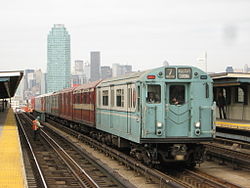| R33S | |
|---|---|
 R33S car 9306, in its original colors, leads the Train of Many Colors through 40 Street–Lowery St on a <7> express run to Mets–Willets Point. | |
 Interior of R33S car 9306 | |
| In service | 1963–2003 |
| Manufacturer | St. Louis Car Company |
| Built at | St. Louis, Missouri, United States |
| Constructed | 1963 |
| Entered service | 1963 |
| Refurbished | 1985 |
| Scrapped | 2001 (9321) 2010 (9339) 2013 (several cars) |
| Number built | 40 |
| Number in service | (23 in work service) |
| Number preserved | 6 |
| Number scrapped | 10 |
| Successor | R142 and R142A |
| Formation | Single unit cars |
| Fleet numbers | 9306–9345 |
| Capacity | 44 (seated) |
| Operators | New York City Subway |
| Specifications | |
| Car body construction | LAHT (Low Alloy High Tensile) steel |
| Car length | 51.04 feet (15.56 m) |
| Width | 8.75 feet (2,667 mm) |
| Height | 11.86 feet (3,615 mm) |
| Doors | 6 sets of 50 inch wide side doors per car |
| Weight | 75,122 lb (34,075 kg) (pre-rebuild) |
| Traction system | Westinghouse XCA248E with Westinghouse (WH) 1447C |
| Auxiliaries | Motor-generator and battery set (WH YX304E) |
| Electric system(s) | 600 V DC Third rail |
| Current collection | Contact shoe |
| Braking system(s) | WABCO, "SMEE" (electrodynamic) |
| Track gauge | 4 ft 8+1⁄2 in (1,435 mm) standard gauge |
The R33S [1] (also known as R33 World's Fair or R33WF) was a New York City Subway car that was built by St. Louis Car Company in 1963 for the IRT A Division. They were purchased for service on the IRT Flushing Line (7 and <7> trains), which was the closest line to the 1964 New York World's Fair. A total of 40 cars were built, arranged as single cars. While in regular service, each R33S was coupled to five two-car consists of R36 cars to make 11-car trains for the 7 and <7> routes.
Contents
The R33S fleet entered service on September 26, 1963, and was originally painted in a light blue turquoise "Bluebird" scheme. The fleet was overhauled in the mid-1980s, during which the cars were painted red, leading to the nickname "Redbirds". The R33S fleet was replaced in the early 2000s with the delivery of the R142 and R142A cars, with the last train of R33S and R36s running on November 3, 2003. After being retired, some R33S cars were preserved, but most were kept for work service; many of the work cars were scrapped in the 2010s.

